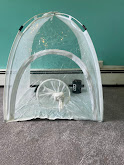During my first week as an intern, I got a taste for both lab and field work!! In the lab, I first learned common types of mosquitoes including the Asian Tiger mosquito or Aedes Albopictus, which we will be working with over the course of the summer. I worked with “Dr. Jack” Petersen a lot this week, and he was incredibly informative on all things mosquitoes! I was very excited to get started, and we set up a new infirmary as well as a sample bioassay on the first day. I already feel more confident in my ability to determine different life stages of the mosquitoes. Additionally, much of the first week was defining the first bioassay we are going to be running with Natular SC, which is a larvicide that would be new to New Jersey.
Our research question is how many microliters of Natular SC are needed to treat 100 L of larvae? We hope to answer the question through a regression and probit analysis of the data. We then decided 8 different concentrations to use for 8 different treatments ranging from 1 microliter to 0.01 microliters. With most of the planning done, we hatched eggs and will hopefully be able to start the first bioassay next week! This week, I also learned why Natular SC is being used in this experiment. Natular SC has not been used to treat mosquito larvae in New Jersey. The goal of the bioassay is to more specifically determine the optimal concentration in a volumetric unit instead of by surface area. Then, data can be used to hopefully add Natular SC to the rotation of insecticides used to treat mosquitoes to further prevent resistance.
As I previously said, I also experienced some field work. I was able to go out one day to watch how black flies were treated around Hunterdon County. I visited 4 different sites to watch, and I was also able to get in the water at two sites because the water was low enough in order to search for black fly larvae on leaves. Later that day, we went back to check mortality. Furthermore, I learned the process of setting up mosquito traps and went along to a few different sites. One thing I learned is definitely why they call the water placed in the trap “stink water.” Plus, it was interesting to see how all of the different aspects of mosquito control connect to each other. I feel like I have already learned so much, and I am ready to continue next week!



Comments
Post a Comment